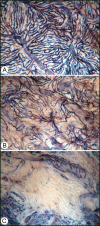Effects of diabetes on the eye
- PMID: 24335073
- PMCID: PMC3864380
- DOI: 10.1167/iovs.13-12979
Effects of diabetes on the eye
Abstract
Hyperglycemia has toxic effects on almost all cells in the body. Ophthalmic complications of hyperglycemia are most profound in cornea and retina. Seventy percent of diabetics suffer from corneal complications, collectively called diabetic keratopathy, which includes include recurrent erosions, delayed wound healing, ulcers, and edema. Confocal microscopy has permitted in vivo imaging of corneal nerves, which are also affected in diabetic subjects. Gene therapies upregulating MNNG HOS transforming gene (cMet) and/or downregulating MMP10 and cathepsin S are potential future therapies for diabetic keratopathy. Diabetic retinopathy (DR) is the most common cause of blindness in people over the age of 50. There is accumulating evidence that DR is an inflammatory disease. The initial events in animal models of DR are increased vascular permeability and leukostasis. This binding of leukocytes to the endothelium results from an increase in intracellular adhesion molecule-1 (ICAM-1) on the retinal capillary endothelium (EC) and expression of CD11/CD18 on the surface of the activated leukocyte. We have observed polymorphonuclear leukocytes (PMNs) at sites of EC vascular dysfunction in diabetic retinas as well as choroid. Anti-inflammatory drugs like etanercept, aspirin, or meloxicam reduce leukostasis and EC death. Future therapies may include repopulation of the acellular capillaries after EC and pericyte death with vascular progenitors made from the patient's own blood cells.
Keywords: choroidopathy; cornea; diabetes; inflammation; retinopathy.
Figures




Similar articles
-
Nonsteroidal anti-inflammatory drugs prevent early diabetic retinopathy via TNF-alpha suppression.FASEB J. 2002 Mar;16(3):438-40. doi: 10.1096/fj.01-0707fje. Epub 2002 Jan 30. FASEB J. 2002. PMID: 11821258
-
A central role for inflammation in the pathogenesis of diabetic retinopathy.FASEB J. 2004 Sep;18(12):1450-2. doi: 10.1096/fj.03-1476fje. Epub 2004 Jul 1. FASEB J. 2004. PMID: 15231732
-
Integrin-mediated neutrophil adhesion and retinal leukostasis in diabetes.Invest Ophthalmol Vis Sci. 2000 Apr;41(5):1153-8. Invest Ophthalmol Vis Sci. 2000. PMID: 10752954
-
Leukocytes in diabetic retinopathy.Curr Diabetes Rev. 2007 Feb;3(1):3-14. doi: 10.2174/157339907779802139. Curr Diabetes Rev. 2007. PMID: 18220651 Review.
-
Experimental modeling of cornea wound healing in diabetes: clinical applications and beyond.BMJ Open Diabetes Res Care. 2019 Nov 27;7(1):e000779. doi: 10.1136/bmjdrc-2019-000779. eCollection 2019. BMJ Open Diabetes Res Care. 2019. PMID: 31803484 Free PMC article. Review.
Cited by
-
Active-fluidics-based torsional phacoemulsification in diabetic eyes: A prospective interventional study.Indian J Ophthalmol. 2019 May;67(5):619-624. doi: 10.4103/ijo.IJO_1146_18. Indian J Ophthalmol. 2019. PMID: 31007221 Free PMC article.
-
Resolvin D1 promotes corneal epithelial wound healing and restoration of mechanical sensation in diabetic mice.Mol Vis. 2018 Apr 1;24:274-285. eCollection 2018. Mol Vis. 2018. PMID: 29643724 Free PMC article.
-
Correlation between glycemic control and peripapillary retinal nerve fiber layer thickness in Saudi type II diabetics.Clin Ophthalmol. 2018 Mar 1;12:419-425. doi: 10.2147/OPTH.S151564. eCollection 2018. Clin Ophthalmol. 2018. PMID: 29535499 Free PMC article.
-
Dysregulation of the OGF-OGFr pathway correlates with elevated serum OGF and ocular surface complications in the diabetic rat.Exp Biol Med (Maywood). 2020 Sep;245(15):1414-1421. doi: 10.1177/1535370220940273. Epub 2020 Jul 8. Exp Biol Med (Maywood). 2020. PMID: 32640891 Free PMC article.
-
Application of the Active-Fluidics System in Phacoemulsification: A Review.J Clin Med. 2023 Jan 12;12(2):611. doi: 10.3390/jcm12020611. J Clin Med. 2023. PMID: 36675540 Free PMC article. Review.
References
-
- Midena E, Brugin E, Ghirlando A, Sommavilla M, Avogaro A. Corneal diabetic neuropathy: a confocal microscopy study. J Refract Surg. 2006; 22: S1047–S1052 - PubMed
-
- Midena E, Cortez M, Miotto S, Gambato C, Cavarzeran F, Ghirlando A. Confocal microscopy of corneal sub-basal nerve plexus: a quantitative and qualitative analysis in healthy and pathologic eyes. J Refract Surg. 2009; 25: S125–S130 - PubMed
-
- Chikama T, Wakuta M, Liu Y, Nishida T. Deviated mechanism of wound healing in diabetic corneas. Cornea. 2007; 26: S75–S81 - PubMed
Publication types
MeSH terms
Substances
Grants and funding
LinkOut - more resources
Full Text Sources
Other Literature Sources
Medical
Miscellaneous

